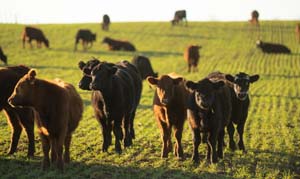
Step into the meat aisle today and it can feel like you’re reading a foreign language—organic, grass-fed, free-range, hormone-free, non-GMO. It’s a lot to take in, and let’s face it: most of us just want to know what’s actually better—for our health, for the flavor, and for how the animal was raised.
Understanding Organic, Grass-Fed, and Free-Range Beef
We believe that understanding where your meat comes from is just as important as how it tastes. So, we’re cutting through the jargon to explain what these common beef labels really mean—and how they impact everything from nutrition to taste. Let’s get into the difference between organic, grass-fed, and free-range beef.
Organic Beef: Clean Eating from the Ground Up
Let’s start with organic beef. All beef comes from cows, of course, but organic certification goes far beyond that. To be labeled organic, the cattle must be raised under strict guidelines that prioritize both environmental and animal welfare. That includes no synthetic hormones or antibiotics, no GMOs, no artificial fertilizers or pesticides—not even on the grass they graze on—and no prolonged confinement or unsanitary feedlot conditions. Even the fields the cows graze in must meet organic standards. The idea is to eliminate synthetic exposure at every level—from soil to steak. If you’re concerned about chemical residues in your food or the long-term effects of additives, organic beef is a smart, clean choice. It also supports farms that focus on humane animal treatment and environmental sustainability.
Grass-Fed Beef: Natural Diet, Bold Flavor
Next up is grass-fed beef, which refers to how the animal was fed, rather than how it was treated. Grass-fed cows eat a natural diet of grass (surprise!) and are often allowed to graze freely. In colder seasons, they might also be fed hay or alfalfa, but no grains or processed feed. The result? Grass-fed beef is typically leaner and lower in fat, higher in heart-healthy omega-3s and antioxidants, and packed with rich, slightly earthy flavor. However, it’s important to note that “grass-fed” doesn’t automatically mean “organic.” The pastures they graze on may still be treated with synthetic fertilizers or pesticides, and unless it’s labeled as grass-fed and organic, there’s no guarantee the cow was raised without antibiotics or hormones.
Free-Range Beef: Room to Roam
Free-range beef describes how the animal was raised in terms of space and lifestyle. Free-range cattle are not confined to crowded feedlots—they’re given room to roam, graze, and engage in natural behaviors. Often, free-range overlaps with grass-fed—since cows that roam typically graze—but the free-range label doesn’t guarantee what the animals were fed or whether any hormones or antibiotics were used; it simply means the cows had access to open land rather than living in tight quarters. Free-range beef appeals to those who care about animal welfare and believe that animals raised with dignity and freedom produce better, healthier meat.
Which One Is Right for You?
The truth is, there’s no one-size-fits-all answer—it depends on your values, taste preferences, and dietary needs.
Here’s a quick cheat sheet to help:
- Want zero exposure to synthetic additives? Go organic.
- Prefer bold flavor and a leaner cut? Grass-fed is the way to go.
- Focused on animal welfare and ethical farming? Look for free-range.
You’ll also find combinations like “organic grass-fed” or “free-range, no antibiotics.” These are ideal if you want the benefits of multiple practices in one package.
At Wholey, We Keep It Transparent
We know choosing the right beef shouldn’t require a degree in food science. That’s why we’re here—to offer quality meats you can trust, backed by clear labeling and honest sourcing. Whether you’re grilling up steaks, slow-roasting brisket, or making weeknight tacos, we’ve got the cuts that suit your standards—and your table. Because when it comes to premium beef, knowledge is power—and flavor.

